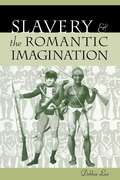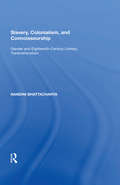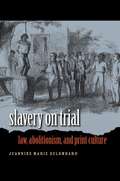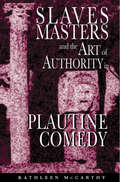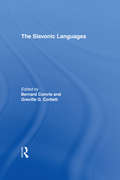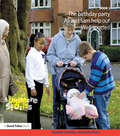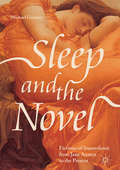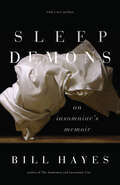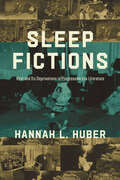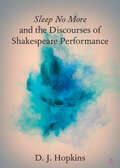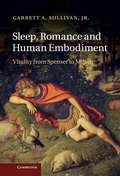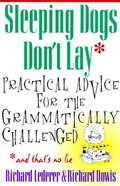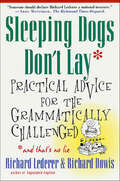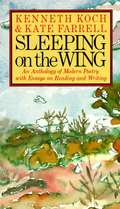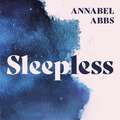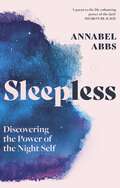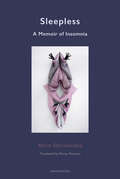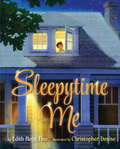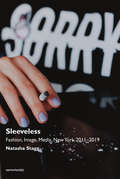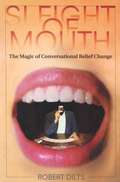- Table View
- List View
Slavery and the Romantic Imagination
by Debbie LeeSelected by Choice magazine as an Outstanding Academic TitleThe Romantic movement had profound social implications for nineteenth-century British culture. Among the most significant, Debbie Lee contends, was the change it wrought to insular Britons' ability to distance themselves from the brutalities of chattel slavery. In the broadest sense, she asks what the relationship is between the artist and the most hideous crimes of his or her era. In dealing with the Romantic period, this question becomes more specific: what is the relationship between the nation's greatest writers and the epic violence of slavery? In answer, Slavery and the Romantic Imagination provides a fully historicized and theorized account of the intimate relationship between slavery, African exploration, "the Romantic imagination," and the literary works produced by this conjunction.Though the topics of race, slavery, exploration, and empire have come to shape literary criticism and cultural studies over the past two decades, slavery has, surprisingly, not been widely examined in the most iconic literary texts of nineteenth-century Britain, even though emancipation efforts coincide almost exactly with the Romantic movement. This study opens up new perspectives on Blake, Wordsworth, Coleridge, Percy Bysshe Shelley, Mary Shelley, Keats, and Mary Prince by setting their works in the context of political writings, antislavery literature, medicinal tracts, travel writings, cartography, ethnographic treatises, parliamentary records, philosophical papers, and iconography.
Slavery, Colonialism and Connoisseurship: Gender and Eighteenth-Century Literary Transnationalism
by Nandini BhattacharyaColonization, slavery, traffic in women, and connoisseurship seem to have particularly captured the imaginations of circumatlantic writers of the later eighteenth century. In this book, Nandini Bhattacharya examines the works of such writers as Richard Brinsley Sheridan, George Colman Jr., James Cobb and Phillis Wheatley, who redefined ideas about Value and Taste. Writers re-presented the ethical debate on Value and trade through aesthetic metaphors and discourse, thus disguising the distasteful nature of the ownership and exchange of human beings and mitigating the guilt associated with that traffic. Bhattacharya explores the circumatlantic redefinition of Taste and Value as cultural and moral concepts in gender and racial discourses in slave-owning, colonizing, and connoisseurial Britain, and demonstrates how Value and aesthetics were redefined in late eighteenth-century circumatlantic discourses with particular focus on the language of slavery, trade and connoisseurship. She also delineates the workings of transnational consciousness and experience of race, class, gender, slavery, colonialism and connoisseurship in the late eighteenth-century circumatlantic rim. Throughout the study, Bhattacharya rereads late eighteenth-century British literature as a stage for the articulation of theories of difference and domination.
Slavery on Trial
by Jeannine Marie DelombardAmerica's legal consciousness was high during the era that saw the imprisonment of abolitionist editor William Lloyd Garrison, the execution of slave revolutionary Nat Turner, and the hangings of John Brown and his Harpers Ferry co-conspirators. Jeannine Marie DeLombard examines how debates over slavery in the three decades before the Civil War employed legal language to "try" the case for slavery in the court of public opinion via popular print media. Discussing autobiographies by Frederick Douglass, a scandal narrative about Sojourner Truth, an abolitionist speech by Henry David Thoreau, sentimental fiction by Harriet Beecher Stowe, and a proslavery novel by William MacCreary Burwell, DeLombard argues that American literature of the era cannot be fully understood without an appreciation for the slavery debate in the courts and in print. Combining legal, literary, and book history approaches, Slavery on Trial provides a refreshing alternative to the official perspectives offered by the nation's founding documents, legal treatises, statutes, and judicial decisions. DeLombard invites us to view the intersection of slavery and law as so many antebellum Americans did--through the lens of popular print culture.
Slaves and Slavery in Ancient Greek Comic Drama
by Ben Akrigg Rob TordoffHow did audiences of ancient Greek comedy react to the spectacle of masters and slaves? If they were expected to laugh at a slave threatened with a beating by his master at one moment but laugh with him when they bantered familiarly at the next, what does this tell us about ancient Greek slavery? This volume presents ten essays by leading specialists in ancient Greek literature, culture and history, exploring the changing roles and representations of slaves in comic drama from Aristophanes at the height of the Athenian Empire to the New Comedy of Menander and the Hellenistic World. The contributors focus variously on individual comic dramas or on particular historical periods, analysing a wide range of textual, material-culture and comparative data for the practices of slavery and their representation on the ancient Greek comic stage.
Slaves, Masters, and the Art of Authority in Plautine Comedy
by Kathleen McCarthyWhat pleasures did Plautus' heroic tricksters provide their original audience? How should we understand the compelling mix of rebellion and social conservatism that Plautus offers? Through a close reading of four plays representing the full range of his work (Menaechmi, Casina, Persa, and Captivi), Kathleen McCarthy develops an innovative model of Plautine comedy and its social effects. She concentrates on how the plays are shaped by the interaction of two comic modes: the socially conservative mode of naturalism and the potentially subversive mode of farce. It is precisely this balance of the naturalistic and the farcical that allows everyone in the audience--especially those well placed in the social hierarchy--to identify both with and against the rebel, to feel both the thrill of being a clever underdog and the complacency of being a securely ensconced authority figure. Basing her interpretation on the workings of farce and naturalism in Plautine comedy, McCarthy finds a way to understand the plays' patchwork literary style as well as their protean social effects. Beyond this, she raises important questions about popular literature and performance not only on ancient Roman stages but in cultures far from Plautus' Rome. How and why do people identify with the fictional figures of social subordinates? How do stock characters, happy endings, and other conventions operate? How does comedy simultaneously upset and uphold social hierarchies? Scholars interested in Plautine theater will be rewarded by the detailed analyses of the plays, while those more broadly interested in social and cultural history will find much that is useful in McCarthy's new way of grasping the elusive ideological effects of comedy.
Slaves to Rome
by Myles LavanThis study in the language of Roman imperialism provides a provocative new perspective on the Roman imperial project. It highlights the prominence of the language of mastery and slavery in Roman descriptions of the conquest and subjection of the provinces. More broadly, it explores how Roman writers turn to paradigmatic modes of dependency familiar from everyday life - not just slavery but also clientage and childhood - in order to describe their authority over, and responsibilities to, the subject population of the provinces. It traces the relative importance of these different models for the imperial project across almost three centuries of Latin literature, from the middle of the first century BCE to the beginning of the third century CE.
The Slavonic Languages (Routledge Language Family Series)
by Professor Greville Corbett Professor Bernard ComrieIn this scholarly volume, each of the living Slavonic languages are analysed and described in depth, together with the two extinct languages - Old Church Slavonic and Polabian. In addition, the various alphabets of the Slavonic languages - particularly Roman, Cyrillic and Glagolitic - are discussed, and the relationships of the Slavonic languages to other Indo-European languages and to one another, are explored. The last chapter provides an account of those Slavonic languages in exile, for example, Russian, Ukrainian, Polish, Czech and Slovak in the USA.Each language-chapter is written by an expert in the field, in a format designed for comparative study. Information on each language includes: an introductory description of social context and development (where appropriate); a discussion of phonology; a detailed presentation of synchronic morphology, noting major historical developments; comprehensive treatment of syntactic properties; a discussion of vocabulary; an outline of main dialects; and an extensive bibliography, listing English and other sources.
Sledmere Stories - Book 1: The Birthday Party; Ali and Sam Help Out; Well Spotted!
by Linda Evans Amanda GreenleyFirst Published in 2005. Routledge is an imprint of Taylor & Francis, an informa company.
Sleep and the Novel: Fictions Of Somnolence From Jane Austen To The Present
by Michael GreaneySleep and the Novel is a study of representations of the sleeping body in fiction from 1800 to the present day which traces the ways in which novelists have engaged with this universal, indispensable -- but seemingly nondescript -- region of human experience. Covering the narrativization of sleep in Austen, the politicization of sleep in Dickens, the queering of sleep in Goncharov, the aestheticization of sleep in Proust, and the medicalization of sleep in contemporary fiction, it examines the ways in which novelists envision the figure of the sleeper, the meanings they discover in human sleep, and the values they attach to it. It argues that literary fiction harbours, on its margins, a “sleeping partner”, one that we can nickname the Schlafroman or “sleep-novel”, whose quiet absorption in the wordlessness and passivity of human slumber subtly complicates the imperatives of self-awareness and purposive action that traditionally govern the novel.
Sleep Demons: An Insomniac’s Memoir
by Bill HayesWe often think of sleep as mere stasis, a pause button we press at the end of each day. Yet sleep is full of untold mysteries—eluding us when we seek it too fervently, throwing us into surreal dream worlds when we don’t, sometimes even possessing our bodies so that they walk and talk without our conscious volition. Delving into the mysteries of his own sleep patterns, Bill Hayes marvels, “I have come to see that sleep itself tells a story.” An acclaimed journalist and memoirist—and partner of the late neurologist Oliver Sacks—Hayes has been plagued by insomnia his entire life. The science and mythology of sleep and sleeplessness form the backbone to Hayes’s narrative of his personal battles with sleep and how they colored his waking life, as he threads stories of fugitive sleep through memories of growing up in the closet, coming out to his Irish Catholic family, watching his friends fall ill during the early years of the AIDS crisis in San Francisco, and finding a lover. An erudite blend of science and personal narrative, Sleep Demons offers a poignant introduction to the topics for which Hayes has since become famous, including art, eros, city life, the history of medical science, and queer identity.
Sleep Fictions: Rest and Its Deprivations in Progressive-Era Literature (Topics in the Digital Humanities)
by Hannah L. HuberThe literary response to the dawning cult of wakefulness A turn-of-the-century influx of new technologies and the enormous impact of the electric light transformed not only individual sleeping habits but the ways American culture conceived and valued sleep. Hannah L. Huber analyzes the works of Henry James, Edith Wharton, Charles Chesnutt, and Charlotte Perkins Gilman to examine the literary response to the period’s obsession with wakefulness. As these writers blurred the separation of public and private space, their characters faced exhaustion in a modern world that permeated every moment of their lives with artificial light, traffic noise, and the social pressure to remain active at all hours. The implacable cultural clock and constant stress over physical limitations had an even greater impact on marginalized figures. Huber pays particular attention to how these writers rebutted Americans’ confidence in the body’s ability to conquer sleep with vivid portraits of the devastating consequences of sleep disruption and deprivation. The author also provides a website and text visualization tool that offers readers an interdisciplinary, deconstructed analysis of the book’s primary texts. The website can be found at: https://sleepfictions.org/sleep/scalar/index
Sleep No More and the Discourses of Shakespeare Performance (Elements in Shakespeare Performance)
by null D. J. HopkinsThis Element focuses on Sleep No More, theatre adaptation of Macbeth produced by the British company Punchdrunk. This Element frames the Shakespeare adaptation as part of a system of ghostly citationality through which audiences understand the significance of the past in performances today. Hopkins introduces the concept of “uncanny spectatorship” to describe audience practice in Sleep No More and other performance contexts. The Element positions experiences like Sleep No More as forms of critical inquiry, and, despite its seemingly analog format, Sleep No More is discussed as a valuable site for media research. Ultimately, Sleep No More and the Discourses of Shakespeare Performance Sleep No More offers an opportunity to explore a set of concepts that are significant to the subject of Shakespeare Performance and to consider the ways in which audiences interact with bodies, spaces, text, and media.
Sleep, Romance and Human Embodiment: Vitality from Spenser to Milton
by Garrett A. Sullivan Jr.Garrett Sullivan explores the changing impact of Aristotelian conceptions of vitality and humanness on sixteenth- and seventeenth-century literature before and after the rise of Descartes. In the Renaissance, Aristotle's tripartite soul is usually considered in relation to concepts of psychology and physiology. However, Sullivan argues that its significance is much greater, constituting a theory of vitality that simultaneously distinguishes man from, and connects him to, other forms of life. He contends that, in works such as Sidney's Old Arcadia, Shakespeare's Henry IV and Henry V, Spenser's Faerie Queene, Milton's Paradise Lost and Dryden's All for Love, the genres of epic and romance, whose operations are informed by Aristotle's theory, provide the raw materials for exploring different models of humanness; and that sleep is the vehicle for such exploration as it blurs distinctions among man, plant and animal.
Sleeping Dogs Don't Lay: Practical Advice for the Grammatically Challenged
by Richard Lederer Richard DowisFor years Richard Lederer has enthralled fans of the English language with his keen insights, commonsense advice, and witty presentation. Now Lederer has teamed up with Richard Dowis to take readers on another journey through the world's most wonderful, albeit perplexing, language. How many times have we all heard the word viable used in company meetings? Lederer and Dowis show us how "viable," somewhere along the line, was extracted from medical books, where it literally means "capable of living," and placed into the business lexicon, where it means. . . well, who knows? The authors clear up once and for all the confusion between lay and lie and put to rest some common myths about language. The book's finale is a ten-minute writing lesson from which everyone, from rank amateur to seasoned pro, can benefit. These and dozens of other features make this book pure pleasure for language buffs, writers, and teachers. Sleeping Dogs Don't Lay is useful and authoritative as well as fun to read, with humorous touches often popping up where least expected and most needed.
Sleeping Dogs Don't Lay: Practical Advice for the Grammatically Challenged
by Richard Lederer Richard DowisFor years Richard Lederer has enthralled fans of the English language with his keen insights, commonsense advice, and witty presentation. Now Lederer has teamed up with Richard Dowis to take readers on another journey through the world's most wonderful, albeit perplexing, language. How many times have we all heard the word viable used in company meetings? Lederer and Dowis show us how "viable," somewhere along the line, was extracted from medical books, where it literally means "capable of living," and placed into the business lexicon, where it means...well, who knows?The authors clear up once and for all the confusion between lay and lie and put to rest some common myths about language. The book's finale is a ten-minute writing lesson from which everyone, from rank amateur to seasoned pro, can benefit. These and dozens of other features make this book pure pleasure for language buffs, writers, and teachers. Sleeping Dogs Don't Lay is useful and authoritative as well as fun to read, with humorous touches often popping up where least expected and most needed.
Sleeping on the Wing: An Anthology of Modern Poetry with Essays on Reading and Writing
by Kenneth Koch Kate FarrellSelections from the work of twenty-three modern poets, from Emily Dickinson and Gerard Manley Hopkins to Gary Snyder and Leroi Jones, including translations of poems by five European poets.
Sleepless: Discovering the Power of the Night Self
by Annabel Abbs'Sleepless has changed how I feel about sleep . . . I was captivated' The Times, Book of the Week'This book will inspire you to get up, light a candle, and experience your own Night Self' Financial TimesTHE NIGHT SELF IS: CREATIVE. CURIOUS. VULNERABLE. ENCHANTED. COURAGEOUS.In the winter of 2020, Annabel Abbs experienced a series of bereavements. As she grieved, she kept busy by day, but at night sleep eluded her. And yet her sleeplessness led to a profound and unexpected discovery: her Night Self. As the night transformed into a place of creativity and liberation, Annabel found she wasn't alone. From the radical fifteenth-century philosopher Laura Cereta and subversive artist Louise Bourgeois, to Virginia Woolf and the activist Peace Pilgrim, women have long found sanctuary, inspiration and courage in darkness.Drawing on the latest science, which shows we are more imaginative, open-minded and reflective at night, Annabel set out to discover the potential of her Night Self. Sleepless follows her journey, from midnight hikes to starlit swims, from Singapore, the brightest city on Earth, to the darkest corner of the Arctic Circle, and finally to that most elusive of places - sleep.A moving, revelatory voyage into the dark, Sleepless invites us to feel less anxious about our sleep, and to embrace the possibilities of the night.
Sleepless: Discovering the Power of the Night Self
by Annabel Abbs'Sleepless has changed how I feel about sleep . . . I was captivated' The Times, Book of the Week'This book will inspire you to get up, light a candle, and experience your own Night Self' Financial TimesTHE NIGHT SELF IS: CREATIVE. CURIOUS. VULNERABLE. ENCHANTED. COURAGEOUS.In the winter of 2020, Annabel Abbs experienced a series of bereavements. As she grieved, she kept busy by day, but at night sleep eluded her. And yet her sleeplessness led to a profound and unexpected discovery: her Night Self. As the night transformed into a place of creativity and liberation, Annabel found she wasn't alone. From the radical fifteenth-century philosopher Laura Cereta and subversive artist Louise Bourgeois, to Virginia Woolf and the activist Peace Pilgrim, women have long found sanctuary, inspiration and courage in darkness.Drawing on the latest science, which shows we are more imaginative, open-minded and reflective at night, Annabel set out to discover the potential of her Night Self. Sleepless follows her journey, from midnight hikes to starlit swims, from Singapore, the brightest city on Earth, to the darkest corner of the Arctic Circle, and finally to that most elusive of places - sleep.A moving, revelatory voyage into the dark, Sleepless invites us to feel less anxious about our sleep, and to embrace the possibilities of the night.
Sleepless: A Memoir of Insomnia
by Marie DarrieussecqA restless inquiry into the cultural and psychic sources of insomnia by one of contemporary French literature&’s most elegant voices.Plagued by insomnia for twenty years, Marie Darrieussecq turns her attention to the causes, implications, and consequences of sleeplessness: a nocturnal suffering that culminates at 4 a.m. and then defines the next day. &“Insomniac mornings are dead mornings,&” she observes. Prevented from falling asleep by her dread of exhaustion the next day, Darrieussecq turns to hypnosis, psychoanalysis, alcohol, pills, and meditation. Her entrapment within this spiraling anguish prompts her inspired, ingenious search across literature, geopolitical history, psychoanalysis, and her own experience to better understand where insomnia comes from and what it might mean. There are those, she writes, in Rwanda, whose vivid memories of genocide leave them awake and transfixed by complete horror; there is the insomnia of the unhoused, who have nowhere to put their heads down. The hyperconnection of urban professional life transforms her bedroom from a haven to a dormant electrified node. Ranging between autobiography, clinical observation, and criticism, Sleepless is a graceful, inventive meditation by one of the most daring, inventive novelists writing today.
The Sleepy Little Alphabet: A Bedtime Story from Alphabet Town
by Melissa Sweet Judy SierraA fun read-aloud for little ones who are learning their ABCs.It's sleepy time in Alphabet Town. But the twenty-six little letters of the alphabet all have something they need--or want--to do before big-letter moms and dads tuck them in. Not since the classsic Chicka Chicka Boom Boom has there been such an appealing way to teach the youngest child the ABCs while providing a one-minute goodnight story. Of course, Melissa Sweet's animated watercolor, pencil, and collage illustrations may beg for a little more time to match up all the toys with the right letters, and Judy Sierra's rollicking rhymed story will want to be heard again and again. Okay, so maybe it's a three-minute story!
Sleepytime Me
by Edith Hope Fine Christopher DeniseSplashy sunset paints the sky. Shy moon tiptoes, climbs up high . . . Daylight is fading and night is drawing in. It's time for bed. A drowsy child observes the wide world settling down, coming ever closer to home until at last there are good-night hugs and kisses for this little sleepyhead. Richly painted, evocative scenes illuminate the text, imbuing the whole with mystery and a sense of comfort and warmth, and making this a bedtime story to treasure for all time.From the Hardcover edition.
Sleeveless: Fashion, Image, Media, New York 2011-2019 (Semiotext(e) / Native Agents)
by Natasha StaggEssays and stories on fashion, art, and culture in the New York of the 2010s.We were supposed to meet Rose McGowan at Café d'Alsace after the party, but she cancelled at the last minute. I saw on Twitter that she had been hit with a drug possession charge, which she insisted was a scheme to keep her Weinstein dirt quiet. I hadn't even read her Weinstein story… I still wanted to know that the articles were being published, and in large quantities, but reading stories of abuse and humiliation was as stupefying as a hangover. I didn't feel empowered; I only felt more hopeless. I wanted to watch the patriarchy go up in flames, but I wasn't excited about what was being pitched to replace it. If we got all of it out in the open, what would we have left? My fear was that guilt would destroy the classics and there'd be no one left to fuck. All movies would be as low-budget and as puritanical as the stuff they play on Lifetime, all of New York would look like a Target ad, every book or article would be a cathartic tell-all, and I'd be sexually frustrated but too ashamed to hook up with assholes, or even to watch porn.—from SleevelessEve Babitz meets Roland Barthes in Sleeveless, Natasha Stagg's follow up to Surveys, her 2016 novel about internet fame. Composed of essays and stories commissioned by fashion, art, and culture magazines, Sleeveless is a scathing and sensitive report from New York in the 2010s. During those years, Stagg worked as an editor for V magazine and as a consultant, creating copy for fashion brands. Through these jobs, she met and interviewed countless industry luminaries, celebrities, and artists, and learned about the quickly evolving strategies of branding. In Sleeveless, she exposes the mechanics of personal identity and its monetization that propelled the narrator of Surveys from a mall job in Tucson to international travel and internet fame.
Sleight of Mouth: The Magic of Conversational Belief Change
by Robert B. DiltsRobert B. Dilts has been a developer, author, and consultant in the field of Neuro-Linguistic Programming since the mid 1970's. His work has explored the practical applications of cognitive strategies and belief systems to such areas as Creativity, Learning, Health, and Leadership.
